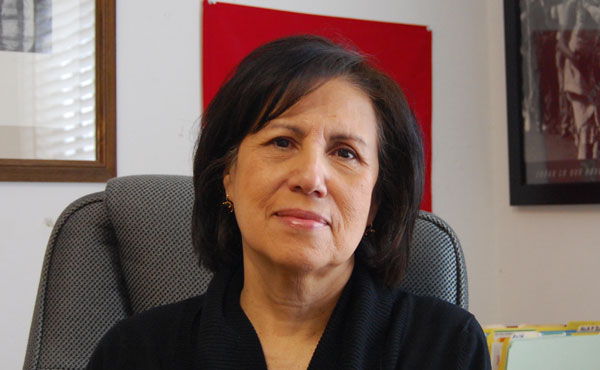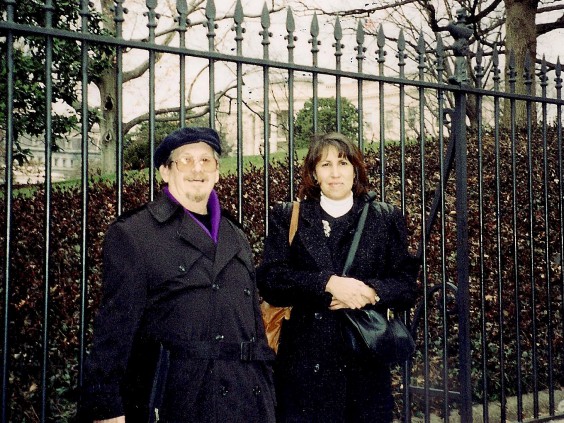“Who I am in this life”: An Interview with María López De León
by Joshua Barnes / May 6, 2014 / No comments
María López De León is the Executive Director and board member of the National Association of Latino Arts and Cultures (NALAC), the nation’s leading nonprofit organization exclusively dedicated to the promotion, advancement, development, and cultivation of Latino arts. Based in San Antonio, Texas it has been a solid base of support for Latino arts since 1989. Though López has worked with NALAC for the last 15 years, she has been an advocate for community, social justice, and cultural heritage since her early life. She sees art and culture as the umbrella that encapsulates these concepts, and says, matter-of-factly, “We cannot build a community without art.”
Last year López was nominated to the National Council of the Arts by President Barack Obama, where she will continue her efforts to expand access to funding opportunities and increase participation from diverse communities.
At the NALAC offices in San Antonio’s West Side, López, who has also been named among the nation’s Fifty Most Powerful and Influential People in the Nonprofit Arts, is not the intimidating, iron-clad character you might expect. Instead, her sunny disposition and passion for her work shone throughout our interview, in which she openly talked about the institutionalized inequities in philanthropy, her activist family, and what it’s like to get a phone call from the White House.
You’ve been the executive director of the National Association of Latino Arts and Culture (NALAC) since 2001. What is the mission of the organization?
NALAC’s mission is to promote, advance, develop, and cultivate the Latino arts field. NALAC’s work is about empowering the Latino arts community and creating a means to promote the multiple perspectives and diverse expressions. We also work across networks and cultures. Through collective work, we can strengthen not just the Latino arts sector but help to create a framework that supports a larger field of diverse and distinctive arts and cultural communities. We would like to see all communities have opportunities to practice their cultural traditions.
From that perspective, how would you define the situation of Latino art in the US today?
Latino artists across the country are doing magnificent, innovative and vibrant work, yet the Latino arts sector is extremely under-capitalized and does not get the attention it deserves in a nation with a rapidly growing Latino population. We need to change that. The field is doing so much with very little; we are good fiscal stewards but I think we can agree that there is a lack of equity in philanthropy. What can we do to change that? I would hope that there is an interest in the mainstream to advance the conversation beyond diversity to equity and equality and make a commitment to increase access and distribute resources in an equitable manner, not only in Latino communities, but across marginalized communities.
When we talk about the Latino community specifically, we’re talking about a group of people from multiple countries and cultures, united through migration. How can we give this diverse community a blanket name like Latino? Is that a helpful thing to do?
The term speaks to our collective power. While most people identify with their country of origin, in the United States identifying as Latina/o is a term that speaks to the fact that, while we have many different cultural, religious, and political perspectives, we do have common stories of colonization, language, and an indigenous heritage.
To that end, the border town of Laredo, Texas hosts one of the largest annual celebrations of George Washington’s birthday. The celebration includes the tradition of Las Marthas, where society daughters debut in elaborate colonial-style dresses to reenact a ball thrown by Martha Washington. How does a tradition like this support and confront a lot of what you just said?
We all reconcile our history in different ways. That particular celebration speaks to two very different histories, yet some members of that community identify with that celebration and take pride in it. Perhaps the thought is that it speaks to a shared ‘American’ story in spite of the realities of oppression and injustice borne by our communities.
- María López De León
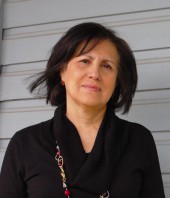
- is the Executive Director and board member of the National Association of Latino Arts and Cultures (NALAC). In January 2013, President Obama appointed her to serve on the National Council on the Arts and in 2012, she was named among the nation’s Fifty Most Powerful and Influential People in the Nonprofit Arts.
- She has over twenty years of multifaceted experience in grass roots community efforts across the country, and serves on the board of the First People’s Fund, the Performing Arts Alliance, and is an advisory council member of San Anto Cultural Arts and Women of Color in the Arts. She is a fellow of the Rockwood Leadership Institute and the Wallace Foundation Leadership in Excellence and Arts Participation (LEAP) program. She studied Journalism at the University of Texas at El Paso.
And you have this perspective from your 15 years of experience with NALAC. How did you first get involved with the organization?
I will have been with NALAC for 16 years this July. But arts and culture, what they bring to communities, and how integral they are to our everyday lives, have always been important to me. Furthermore, speaking up on behalf of justice and against inequality is who I am in this life.
I was born and raised in Hondo, a small community in Texas, where my parents were very involved community organizers. They were always promoting our culture and heritage, and working to ensure that there was equity, equality, and justice in our community. I remember when I was twelve years old, before my dad would go to work, he’d tell my mom to get signatures on petitions so the streets could be paved or streetlights could be installed. Since my mom was busy raising my brothers and sisters, she’d tell my sister and me to go down the street and get the signatures. We’d knock on doors and ask people to sign the petitions, and they’d do it. My parents were also part of the G.I. Forum and the League of United Latin American Citizens, so when the Chicano Rights movement came around in the 1960s we were already involved with all of that.
When I came to work at NALAC I knew one of the founders, the first executive director, Pedro Rodriguez. At the time I was divorced, had three children, and was working in the medical field because it was stable. When I first spoke to Pedro I told him I could only work for NALAC temporarily, but then I came and never left. Together we moved NALAC out to a new space in the West Side, the oldest Mexican-American community here in San Antonio, and the neighborhood where NALAC has always been. When Pedro retired, the board selected me as the new executive director.
That was in 2002. What was happening at NALAC from its founding in 1989 until the point in time when you became executive director?
During this period NALAC was engaged in advocacy and networking. NALAC convened National Conferences, Regional Workshops, launched a mentorship program, completed a survey of the Latino arts field, established the Leadership Institute, and expanded its communication with the Latino arts community.
Since that time many changes have happened, not the least of which is the current renovation of a new office and community center and the expansion of the NALAC Leadership Institute. How do you think Pedro Rodriguez would see the organization today?
I hope that Pedro and the other founders of NALAC are proud of the progress the organization has made. As a team we’ve managed to continue the national renaissance of Latino arts and culture. You see, we’re building a new movement of people who are realizing the opportunities that develop when we work together not only as a Latino community, but also across cultures. We have deep relationships with organizations such as the First Peoples Fund, Alternate Roots, and others, with the understanding that while we are distinctive, we share similar values and are creating the change we want to see.
You also started three grants that cover a wide footprint: The NALAC Fund for the Arts, the Transnational Culture Remittances grant, and the Diverse Arts Spaces Program grant. How have these grants advanced the state of Latino arts in the US and beyond?
The NALAC Fund for the Arts (NFA) was our very first grant program, launched in 2005. In our work with the Latino arts community, we consistently heard that sufficient financial resources were not available. We gathered the field to help us think about the developing a way to provide this support—aside from advocating for changes in policy—and decided to implement the NFA. Nine years later, it remains the only national fund specifically for Latino artists and arts organizations.
The Ford Foundation–Roberta Uno in particular–was the first to invest in our vision to establish the NALAC Fund for the Arts. Other current stakeholders include the Surdna Foundation and Southwest Airlines and past partners include the JP Morgan Chase Foundation, the City of San Antonio Cultural Collaborative, Heineken, MetLife Foundation, and Nescafe among others. The NFA has provided many small organizations, ensembles, and artists with their very first grant and many consider an NFA grant to be a validation from their peers. In the past, the NFA has focused its support on small and midsize organizations, but this year we’ve changed the eligibility to include all organizations, regardless of their budget size.
We’ve also increased the number of master artists that will be awarded. Through the Master Artist program, awards between $7,000 to $20,000 have been made to accomplished artists to mentor a younger artist. The Master Artist grant is a recognition of artistic excellence that acknowledges the merit and impact of the work.
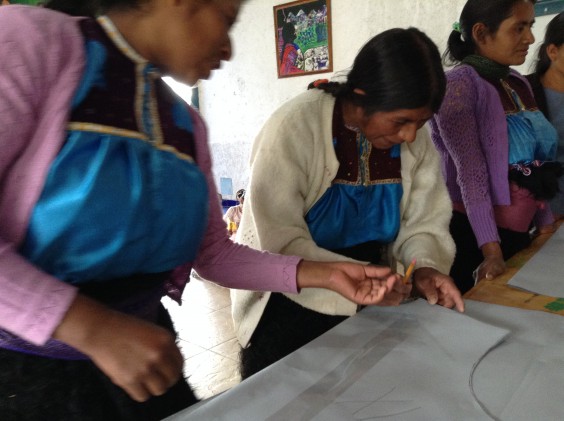
Doña Pascuala and two women from Bautista Chico cut patterns for blouses in Chiapas, Mexico. Photo: Conectando Hilos de la Justicia (Threads of Justice), Josefina Castillo.
The Transnational Cultural Remittances grant (TCR) was established four years after the NFA. It started out as a Ford Foundation initiative called the Transnational Economical Justice Initiative (TEJI), that was focused on promoting economic justice in migrant communities in Mexico, Central America and the US. We considered how financial remittances are shared between migrant communities and created the TCR to support the artistic remittances through which cultural and social capital is exchanged.
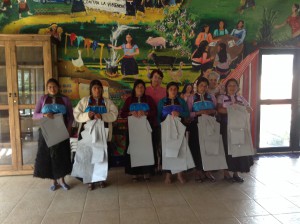
Women from Bautista Chico, Chiapas with Fuerza Unida lead seamstress Leticia Garza exhibit patterns for blouses. Photo: Conectando Hilos de la Justicia (Threads of Justice), Josefina Castillo.
For example, there’s two groups of women that we’ve supported through the TCR for several years. One is a group of Mexican immigrant women in San Antonio who worked for the Levi’s plant before it closed in 1990. When the plant closed, these women created the socially-active sewing collective Fuerza Unida. They’ve been working with Jolom Mayaetik, a collective of indigenous women in Chiapas for many years now, engaging collective learning with each other and other women’s collectives in Chiapas. The women from Fuerza Unida now make beautiful guayaberas that incorporate weaving patterns they learned from the Mayan women in Chiapas. In turn, the women in Chiapas have taken back knowledge to strengthen their sewing collectives.
Finally, we have The Diverse Arts Spaces Grant Program which supports organizations that are part of the Ford Foundation’s Diverse Arts Spaces initiative. The grant allows these organizations to commission or present work by Latino artists. We felt it was important to bring the work of Latino artists to diverse organizations and to new audiences.
Continuing on this wave of progress, last year you were appointed to the National Council on the Arts. How did you receive this important news? A phone call? Tell me about that moment.
I did get a phone call. I was in Washington D.C. for one of NALAC’s next generation leadership training programs and we’d just completed our first day. When I got back to the hotel I had a voicemail from the White House and I actually said, “This is a joke. How did you get my cell number?” That’s the way it started. The call from the White House preceded many conversations with attorneys, the White House personnel office, and the National Endowment for the Arts. It was a rigorous process that took quite a while. After the president nominated me, it went to the Senate, I was approved, and was appointed along with Maria Rosario Jackson and David Masumoto. Right now, the National Council on the Arts is a very diverse council.
So in essence, over the course of your life you went from passing around petitions in Hondo, Texas to a seat in the most important arts organization in the country. How did your parents react when they heard the news?
I lost my dad about a month before President Obama nominated me to the position. My father was very ill, and when I told him that I was being considered for this position he was in the hospital. I could see the pride in his eyes when he looked at me, and he asked, “Is this true?” He died about three days later and though he was unable to be there when I received that honor, I feel that he’s with me all the time.
About a year ago, I was at Americans for the Arts’ Art Advocacy Day and one of the speakers was Judith Canales, from the department of agriculture. I introduced myself to her and she said, “I was in San Antonio when I read about your nomination in the paper. I was so proud.” It turns out, that my father helped her in her campaign for state representative. She told me that if it hadn’t been for my father’s support and help in Medina County, she would not have gotten so many votes. It was a moment of great pride and emotion to know that my father’s name had reached the White House. The work that he, my mother, and others in the community did really made a difference and paved a path for a new generation to advance values of social justice and equality.
What long term plans do you have for NALAC? Where do you want to see yourself and Latino arts in five years?
I see NALAC moving in a good, strategic direction. We’re developing a third component to our Leadership program and will pilot the Advanced Intercultural Leadership Institute in 2015. Through the intercultural institute, mid-level arts professionals from diverse communities will participate in a rigorous program of arts management and leadership development to foster success and demonstrate how intercultural leadership development for the arts can work and be an effective means of enriching the arts. The Advanced Intercultural Institute will connect leaders in diverse communities to share knowledge and understanding across cultures.
Over the next five years, I would like to focus on advocacy, policy, and building a research component at NALAC. After that I want to work in rural communities. There are not enough opportunities and resources are for artists in rural communities. I’d like to work in rural communities in South Texas to do the work that my parents did—to empower and create a consciousness in the next generation to do something new and even more powerful.

